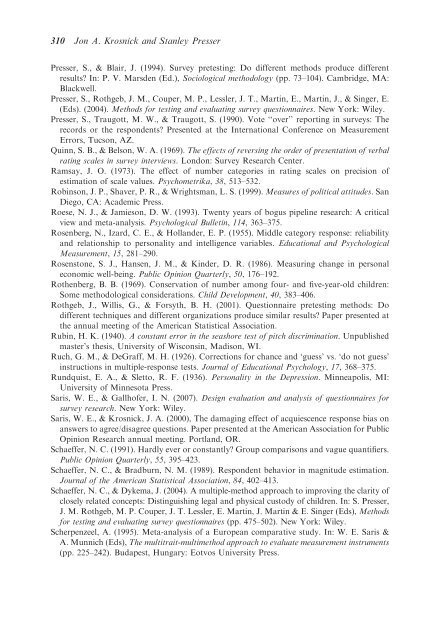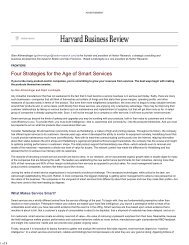Question and Questionnaire Design - Stanford University
Question and Questionnaire Design - Stanford University
Question and Questionnaire Design - Stanford University
Create successful ePaper yourself
Turn your PDF publications into a flip-book with our unique Google optimized e-Paper software.
310 Jon A. Krosnick <strong>and</strong> Stanley PresserPresser, S., & Blair, J. (1994). Survey pretesting: Do different methods produce differentresults? In: P. V. Marsden (Ed.), Sociological methodology (pp. 73–104). Cambridge, MA:Blackwell.Presser, S., Rothgeb, J. M., Couper, M. P., Lessler, J. T., Martin, E., Martin, J., & Singer, E.(Eds). (2004). Methods for testing <strong>and</strong> evaluating survey questionnaires. New York: Wiley.Presser, S., Traugott, M. W., & Traugott, S. (1990). Vote ‘‘over’’ reporting in surveys: Therecords or the respondents? Presented at the International Conference on MeasurementErrors, Tucson, AZ.Quinn, S. B., & Belson, W. A. (1969). The effects of reversing the order of presentation of verbalrating scales in survey interviews. London: Survey Research Center.Ramsay, J. O. (1973). The effect of number categories in rating scales on precision ofestimation of scale values. Psychometrika, 38, 513–532.Robinson, J. P., Shaver, P. R., & Wrightsman, L. S. (1999). Measures of political attitudes. SanDiego, CA: Academic Press.Roese, N. J., & Jamieson, D. W. (1993). Twenty years of bogus pipeline research: A criticalview <strong>and</strong> meta-analysis. Psychological Bulletin, 114, 363–375.Rosenberg, N., Izard, C. E., & Holl<strong>and</strong>er, E. P. (1955). Middle category response: reliability<strong>and</strong> relationship to personality <strong>and</strong> intelligence variables. Educational <strong>and</strong> PsychologicalMeasurement, 15, 281–290.Rosenstone, S. J., Hansen, J. M., & Kinder, D. R. (1986). Measuring change in personaleconomic well-being. Public Opinion Quarterly, 50, 176–192.Rothenberg, B. B. (1969). Conservation of number among four- <strong>and</strong> five-year-old children:Some methodological considerations. Child Development, 40, 383–406.Rothgeb, J., Willis, G., & Forsyth, B. H. (2001). <strong>Question</strong>naire pretesting methods: Dodifferent techniques <strong>and</strong> different organizations produce similar results? Paper presented atthe annual meeting of the American Statistical Association.Rubin, H. K. (1940). A constant error in the seashore test of pitch discrimination. Unpublishedmaster’s thesis, <strong>University</strong> of Wisconsin, Madison, WI.Ruch, G. M., & DeGraff, M. H. (1926). Corrections for chance <strong>and</strong> ‘guess’ vs. ‘do not guess’instructions in multiple-response tests. Journal of Educational Psychology, 17, 368–375.Rundquist, E. A., & Sletto, R. F. (1936). Personality in the Depression. Minneapolis, MI:<strong>University</strong> of Minnesota Press.Saris, W. E., & Gallhofer, I. N. (2007). <strong>Design</strong> evaluation <strong>and</strong> analysis of questionnaires forsurvey research. New York: Wiley.Saris, W. E., & Krosnick, J. A. (2000), The damaging effect of acquiescence response bias onanswers to agree/disagree questions. Paper presented at the American Association for PublicOpinion Research annual meeting. Portl<strong>and</strong>, OR.Schaeffer, N. C. (1991). Hardly ever or constantly? Group comparisons <strong>and</strong> vague quantifiers.Public Opinion Quarterly, 55, 395–423.Schaeffer, N. C., & Bradburn, N. M. (1989). Respondent behavior in magnitude estimation.Journal of the American Statistical Association, 84, 402–413.Schaeffer, N. C., & Dykema, J. (2004). A multiple-method approach to improving the clarity ofclosely related concepts: Distinguishing legal <strong>and</strong> physical custody of children. In: S. Presser,J. M. Rothgeb, M. P. Couper, J. T. Lessler, E. Martin, J. Martin & E. Singer (Eds), Methodsfor testing <strong>and</strong> evaluating survey questionnaires (pp. 475–502). New York: Wiley.Scherpenzeel, A. (1995). Meta-analysis of a European comparative study. In: W. E. Saris &A. Munnich (Eds), The multitrait-multimethod approach to evaluate measurement instruments(pp. 225–242). Budapest, Hungary: Eotvos <strong>University</strong> Press.
















